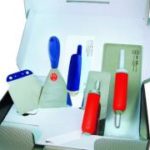How to remove wallpaper glue from the walls to provide the high quality laying of the new wall finishing.
 It is not enough to remove the old wallpaper before applying the new finishing. You should also remove glue from walls. Let’s talk on how to remove wallpaper glue from the vertical surfaces in the fastest way.
It is not enough to remove the old wallpaper before applying the new finishing. You should also remove glue from walls. Let’s talk on how to remove wallpaper glue from the vertical surfaces in the fastest way.
Some people think that the wallpaper glue is removed with chemicals. In fact, the use of chemicals in this case is not a necessary step. The main component of most wallpaper glue types is starch, and it is well softened by water after a time delay of 15 to 30 minutes.
Before you start
You should first and foremost protect the floor – cover it with polyethylene film. Cloths and towels which will be needed for the job, it is desirable to be prepared in advance.
The easiest way to remove wallpaper glue
 Tare a bucket of quite hot water and then add a spoonful of any glass cleaner chemical. This composition helps best to dissolve the glue remaining on the wall after removing the used wallpaper. This simple solution is still the best way to remove wallpaper glue. With a sponge – being constantly dipped into the prepared hot solution – wash the small areas of the surface to soften the glue solidified. In areas with large concentrations of glue or while dealing with drywall, it is recommended to use a brush for it to be wiped more intensively. After removing the glue, the wall must be flushed with fresh cold or warm water. For this, use wet towels or a special cloth eliminating such radicals as glue and detergent. The last challenge is the handling of dry walls with sandpaper to obtain a perfectly flat surface.
Tare a bucket of quite hot water and then add a spoonful of any glass cleaner chemical. This composition helps best to dissolve the glue remaining on the wall after removing the used wallpaper. This simple solution is still the best way to remove wallpaper glue. With a sponge – being constantly dipped into the prepared hot solution – wash the small areas of the surface to soften the glue solidified. In areas with large concentrations of glue or while dealing with drywall, it is recommended to use a brush for it to be wiped more intensively. After removing the glue, the wall must be flushed with fresh cold or warm water. For this, use wet towels or a special cloth eliminating such radicals as glue and detergent. The last challenge is the handling of dry walls with sandpaper to obtain a perfectly flat surface.
Removing wallpaper glue residue
Purification of the residue from the walls of wallpaper can be performed using warm water and vinegar. For each bucket of hot water you will need a cup of vinegar. The resulting composition is applied to the walls and then left for 10 minutes. Then use a scraper and a soft sponge for scraping glue residue off the walls. Washing the walls, as in was the first case, is necessary. Another detergent composition is hot water with baking soda and fabric softener. Quantity is as follows: a bucket of hot water, 1 tablespoon of baking soda and 4 tablespoons of fabric softener.
Pro tips & tricks
- The process is time consuming, but very easy to do if you work in small areas ONLY
- It takes a lot of towels around you to help you to clean up – it’s better to get an assistant
- Using buckets, sponges and hand muscles makes this job a cinch!
- The water should be very hot, so be sure that you will not burn yourself. Be very caref
 ul.
ul. - Wash the walls the way you wash the dishes. Indeed! Use sponges and scrubbers and detergent you walls as you usually wash the dishes.
- After cleaning your walls, empty the bucket of soapy water and replenish it with fresh, clean water for the final washing.
Take a clean washcloth or a sponge and lightly wash your walls again. This washing job is much easier than the first one, because now you are only removing the soapy water from the walls. If the water gets too soapy, dump it out and fill the bucket with fresh water again. This may be 3 or 4 times – so, take your time and be patient.
What to do if the glue dropped on the surface of the new wallpaper?
There is only one way to remove the dried adhesive from the delicate surface. Cover the problematic area with a paper towel and spray it on any glass cleaner chemical. Leave it for 10-15 minutes, remove the towel and pat the spot with a dry cloth.



